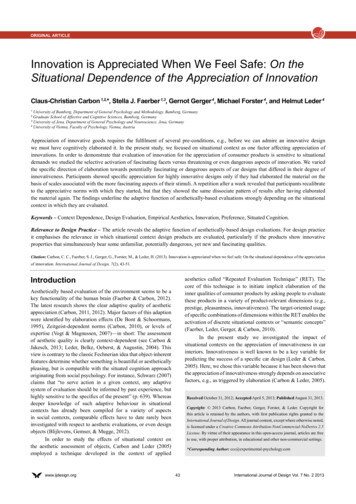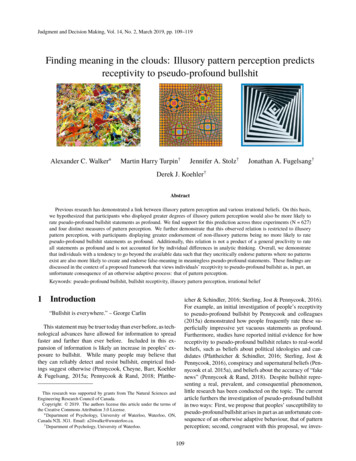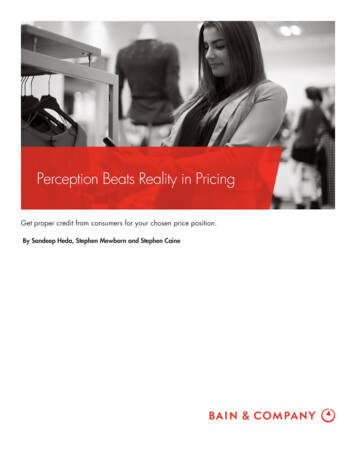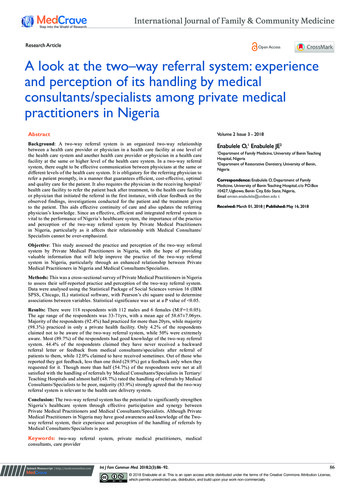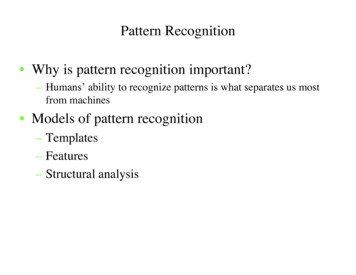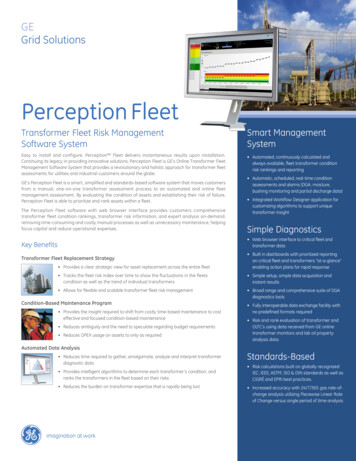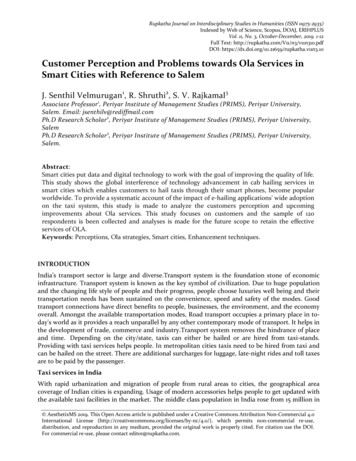
Transcription
Rupkatha Journal on Interdisciplinary Studies in Humanities (ISSN 0975-2935)Indexed by Web of Science, Scopus, DOAJ, ERIHPLUSVol. 11, No. 3, October-December, 2019. 1-12Full Text: http://rupkatha.com/V11/n3/v11n310.pdfDOI: mer Perception and Problems towards Ola Services inSmart Cities with Reference to SalemJ. Senthil Velmurugan 1, R. Shruthi2, S. V. Rajkamal 3Associate Professor 1, Periyar Institute of Management Studies (PRIMS), Periyar University,Salem. Email: jsenthilv@rediffmail.comPh.D Research Scholar 2, Periyar Institute of Management Studies (PRIMS), Periyar University,SalemPh.D Research Scholar 3, Periyar Institute of Management Studies (PRIMS), Periyar University,Salem.Abstract:Smart cities put data and digital technology to work with the goal of improving the quality of life.This study shows the global interference of technology advancement in cab hailing services insmart cities which enables customers to hail taxis through their smart phones, become popularworldwide. To provide a systematic account of the impact of e-hailing applications' wide adoptionon the taxi system, this study is made to analyze the customers perception and upcomingimprovements about Ola services. This study focuses on customers and the sample of 120respondents is been collected and analyses is made for the future scope to retain the effectiveservices of OLA.Keywords: Perceptions, Ola strategies, Smart cities, Enhancement techniques.INTRODUCTIONIndia’s transport sector is large and diverse.Transport system is the foundation stone of economicinfrastructure. Transport system is known as the key symbol of civilization. Due to huge populationand the changing life style of people and their progress, people choose luxuries well being and theirtransportation needs has been sustained on the convenience, speed and safety of the modes. Goodtransport connections have direct benefits to people, businesses, the environment, and the economyoverall. Amongst the available transportation modes, Road transport occupies a primary place in today's world as it provides a reach unparallel by any other contemporary mode of transport. It helps inthe development of trade, commerce and industry.Transport system removes the hindrance of placeand time. Depending on the city/state, taxis can either be hailed or are hired from taxi-stands.Providing with taxi services helps people. In metropolitan cities taxis need to be hired from taxi andcan be hailed on the street. There are additional surcharges for luggage, late-night rides and toll taxesare to be paid by the passenger.Taxi services in IndiaWith rapid urbanization and migration of people from rural areas to cities, the geographical areacoverage of Indian cities is expanding. Usage of modern accessories helps people to get updated withthe available taxi facilities in the market. The middle class population in India rose from 15 million in AesthetixMS 2019. This Open Access article is published under a Creative Commons Attribution Non-Commercial 4.0International License (http://creativecommons.org/licenses/by-nc/4.0/), which permits non-commercial re-use,distribution, and reproduction in any medium, provided the original work is properly cited. For citation use the DOI.For commercial re-use, please contact editor@rupkatha.com.
2Rupkatha Journal, Vol. 11, No. 3, 20191991 to160 million and more in 2016. This segment with its increasing disposable income starteddemanding and has been willing to pay for better services across sectors including private and publictransportation. Rapid economic growth coupled with huge infrastructure development, rigorouseffort from Ministry of Tourism to project India as travel destination and emergence of BusinessProcess Outsourcing (BPO) industry has given a huge push to the car rental industry in India.Till2010, the point-to-point taxi market in India’s big metropolitan cities was completelyunorganized.Taxi services in metropolitan citiesA metropolitan area combines an urban agglomeration (the contiguous, built-up area) with zones notnecessarily urban in character, but closely bound to the center by employment or other commerce.So people migrate within the intra cities so they prefer cab services with gives them comfort and aluxuries journey and seek for quick means of transportation. These outlying zones are sometimesknown as a commuter belt, and may extend well beyond the urban zone, to other political entities.Taxi services in smart citiesTamil Nadu is the second state to hold largest number of smart cities nominated in the list of smartcities in India. Chennai and Coimbatore secured its place in the first list while Vellore, Madurai,Salem and Thanjavur were selected in the second list in 2016 – 2017.Smart City is a concept ofutilizing technologies and connected data sensors to enhance and become powerful in terms ofinfrastructure and city operations. This includes monitoring and managing of public assets,transportation systems, citizens, power plants, water supplies, information systems, civil bodies, andother community services etc., Among various transportation mode cab service gained popularitybecause of its advantage of door to door service and now because of technological advancementcustomers were able to book cabs at competitive price in just one click using their smartphones.These App based cab services were having tremendous potential for growth in denselypopulated countries like India where parking is major problem because of space crunch as well aspublic transports are over cowered during peak hours.Thus, this study tries to capture theperspective of customers on the cab hailing services in Salem city and the level of perseverance’s tothrow some light on the factors which could be a decider for a customer to make his choice amongOla application services available.
3 Customer Perception and Problems towards Ola Services in Smart Cities with Reference to SalemIMPORTANCE OF THE STUDY Among the various options available for consumers in hailing a taxi the researcher wants toidentify the reasons and needs why people choose OLA services in particular and their perceptiontowards online app taxi services.Because Ola works hard to build and maintain its customerexperience. These are the following reasons the researcher has chosen this study, Ola has made the highest turnover in last four years. Ola attracts the customer attention by providing various additional features apart from cabservices they have options like Food panda where they take food orders. They have installed emergency button in their app which when clicked by customer anautomotive trigger goes to their rapid response team who takes an immediate report on theincident and resolves it. They have tied up with an insurance company to give ride insurance at just rupees 1 per ride. They have invented a new category called prime play which gives in cab entertainment helpfulfor longer rides and when traveling with children. Due to the competitive market scenario a detailed study about this helps to analyze about theconsumer needs and improvise the future scope. This study will help us to know the customerssatisfaction with respect to the comfort, convenience, tariff, service quality and staff courtesy, etc.Also, we can have the input and ideas to improve the services to meet out the customerexpectation in the near future.RESEARCH OBJECTIVES To ascertain the importance of cab services in Smart cities. To study the influences of price consciousness of customers while selecting the cab services. To ascertain the customers perception towards online app based cab services. To know the impact of Ola services in Salem. To know the satisfaction level of the customers hailing Ola services.LITERATUREREVIEW(Sagar, 2016)1 had stated that there was demand for Call-a-Cab service offered by Meru Cab. The cabservices are proving security through global positioning system (GPS) and women taxi drivers forwomen passengers especially during night times.According to Harding et al (2016) the auto-rickshaws (three wheelers) are more popular in urbantransport before the advent of cars and cabs.(Yeboah, 2015)2 had argued that driver behavior have negative impact on customer satisfaction inGhana. The variables like continuous service, comfort, reliability and affordability have an impacton customer satisfaction with regard to minicab taxi.1Hanif and Sagar (2016). The cab services are proving security through global positioning system (GPS) andwomen taxi drivers for women passengers especially during night times.
4Rupkatha Journal, Vol. 11, No. 3, 2019According to (al, 2015)3 the self- service mobile technologies helps the commuters to access lot ofdata about cab services and such technologies had changed the role of both customers andcompanies. The adoption of call taxi app (CTA) is impacted perceived usefulness, perceived ease ofuse, subjective norms and perceived playfulness (Peng, Wang,(He, 2014)4. Chen (2014) had explained that mobile apps help both drivers and passengers to findeach other. At present the mobile apps are helps the customers to find cabs. In the recent years thecar rental industry is growing constantly especially in metropolitan cities in India (Rahman, 2014).Geeta Kesavaraj (2013), reveals that “As global competition grows,communication and technologychannels open up new markets, andproducts and services are translated into a wide array of choicesfor ouraudiences, companies must work harder than ever to gain and keepCustomersat a competitivecost.(A, (2016)))5 states that “Call taxi have a greater value in the community,in the taxi industry isregulated in various ways by the state Governments through their respective Departments ofTransport. Through this regulation the Government is able to exert some control over the activities ofthe industry, with the ultimate objective of providing a higher level of service (a complex construct initself) to the public.Ruchi Shukla, Ashish Chandra & Himanshi Jain (20176) states that “Every other day in India, there is anew start up offering efficient cab service to the citizens operating in urban and rural lifestyles. Thisraises a question that is India going through a possible 'Taxi Revolution'ABOUT OLA:Founded in 2011 by Bhavish Aggarwal and Ankit Bhati, Ola is one of the world’s largest ridesharing companies. Ola integrates city transportation for customers and driver-partners onto amobile technology platform ensuring convenient, transparent, and quick service fulfilment. Olais focused on leveraging the best of technology and building innovative solutions groundup,that are relevant at global scale.Notably, in 2016, Ola Play the world’s first connected car platform for ride-sharing waslaunched, transforming commuting experiences and setting the tone for global innovation inthis space. Beyond offering a highly personal experience for users during their rides, Ola Playalso allows its partners like Microsoft, Apple Music, Sony Liv amongst others, to build a highquality interactive and productive experience for its users. Using the Ola mobile app, usersacross 110 cities, can connect with over 1,000,000 driver-partners across cabs, auto-rickshaws,and taxis. Ola has many competitors and the utmost competitor is UBER.Driven by a hyper localapproach, Ola is committed to its mission of building mobility for a billion people. Ola providesvarious additional services like online food orders(Food Panda),cash wallet, etc which promotescustomers attention towards Ola application.2Horsu and Yeboah (2015), has argued that driver behavior has negative impact on the cab services atGhana.3Lu et al (2015), adoption of call taxi app (CTA) is impacted perceived usefulness, perceived ease of use,subjective norms and perceived playfulness.4He, 2014), had explained that mobile apps help both drivers and passengers to find each other5Rexi A. 2016, explained about the various departments of transportation6(Jain, 2017) states about the taxi services in urban and rural areas
5 Customer Perception and Problems towards Ola Services in Smart Cities with Reference to SalemSource: TruecallerMOTIVES OF OLA SERVICESPROMOTIONAL AND MARKETING STRATEGY OF OLA: Ola did many services which convincedpeople to choose Ola services. Some of them are discussed below.ENCOURAGING DRIVERS: They offered micro entrepreneurship for the drivers by helping thedrivers buy their own cars at huge discounts and affordable repayment scheme as they collaboratedwith leading car manufacturers.STRATEGIC PARTNERS WITH MAKE MY TRIP: In the year 2013, Ola cabs launched its partnershipwith make my trip.SATISFACTORY SERVICES TO CUSTOMERS: Customer is at the centre in marketing. The purposeof commercial ads and promotional services is to build customer loyalty.OLA’s SOCIAL SERVICE (Boats): During Chennai floods when people were stuck in their offices orother areas Ola had launched its ferry service. Ola had developed this service so as to help strandedpeople reach home and also to deliver essential material including food, water, etc. The ferries hadprofessional rowers. Each ferry could accommodate 5 to 9 people per trip. They provided three daysservices day and night and later as per the demand of the people.CHALLENGES AND PROBLEMS FACED BY CUSTOMERS AND DRIVERS USING OLAAPPLICATIONDRIVER PROBLEMS Application Usage Training - Unintentional common mistakes include cancelling a ride evenbefore it started, trouble understanding map directions / customer’s location, etc. This leads to abad customer experience. Multiple Affiliations - Many drivers are affiliated to both Ola and Uber. They keep searchingfor customers on both applications. Unethical Extra Charges - Drivers especially at night demand extra cash apart from the farecomputed by the App.
6Rupkatha Journal, Vol. 11, No. 3, 2019TECHNOLOGICAL CHALLENGES: Maps -You have to make multiple phone calls and often show directions (especially to newdrivers) to reach your destination Data Charges - Most of the Indians still uses 2G. WiFi services are unavailable on roads and dataservices are very expensive in India. Protection against Fraud - Tech savvy customers are coming up with innovative ways to earnfree rides.CUSTOMERPROBLEMSPOLICY PROBLEMS: Wrong Incentives - Driver’s share often depends on the number of rides completed rather thanthe total revenue generated. This encourages drivers to undertake shorter trips but leads to adownfall in customer’s satisfaction level. Cab Pooling - Pooling has started very recently in India and is still not available in many cities. Customer Service –When feedback is given against driver proper actions need to be taken,based on the rating given adequate actions needs to be taken. Free Calls - Ola should provide riders with a feature to connect with drivers for free. Each tripwill require just 1 to 2 calls on average. Driver Ratings - Currently there is no mechanism to book a cab only with drivers whose rating X (rated by at least 10 different rider)Research MethodologyResearch can be defined as the search for knowledge or any systematic investigation to establishfacts. The primary purpose of Descriptive research is to provide an accurate description or picture ofthe status or characteristics of a situation or phenomenon and hence the same is adopted in thisstudy.The Convenience sampling method is followed in-order to collect the data through the structuredquestionnaire from the respondents (ref.annexure). The sample size so arrived at is 120 respondentsforming part of customers of Ola taxi service in Salem.Data collection method: Both primary and secondary data is been employed.Tools used: SimplePercentage method, HenryGarettRanking
7 Customer Perception and Problems towards Ola Services in Smart Cities with Reference to SalemDATA ANALYSIS AND INTERPRETATION:SIMPLE PERCENTAGE METHODGenderNo. -305243.3331-403226.6Above 402117.5120100Price4235Comfort2520.83Safety ly8570.83Once a cy of useTotalReasonstouse
8Rupkatha Journal, Vol. 11, No. 3, 2019Airport/Rail2016.6To and from entertainment events6957.5To and from eRANKING ANALYSISTABLE SHOWING THE RESPONDENTS RANKING TOWARDS DIFFICULTIES FACED FROMMOST FACTORDescriptive StatisticsDifficulties facedNMean Std. Deviation Minimum MaximumDrivers irresponsibility1203.892.32919At times drivers cancel the ride1204.582.39319Extra charges for cancelling1205.532.43919Inexperienced drivers1206.162.59619Proper time management is must1204.352.73119Alternate cabs should be specified, if 120any5.452.46619Extra charges on traffic1205.732.38319Maps facilities should be trained1204.442.42819Avoid phone calls while driving1204.782.59819
9 Customer Perception and Problems towards Ola Services in Smart Cities with Reference to SalemDifficulties facedMean RankRanksDrivers irresponsibility3.901At times drivers cancel the ride4.594Extra charges for cancelling5.537Inexperienced drivers6.179Proper time management is must4.362Alternate cabs should be specified, if any5.466Extra charges on traffic5.758Maps facilities should be trained4.473Avoid phone calls while driving4.785A Friedman test was conducted to determine whether participants had a differential rank orderedpreference for the difficulties faced from most factors. Results of that analysis indicated that therewas a differential rank ordered preference for the difficulties faced from most factors, 2(2) 306.319,p .05. A comparison of the rank ordered preferences for the difficulties faced from most factors wasconducted. Results of this analysis indicated that there were significantly more favorable rankings isDrivers irresponsibility over others such as Proper time management ranks 2nd, Maps facilities shouldbe trained3rd , At times drivers cancel the rideranks 4th , ranks Avoid phone calls while driving 5th,Alternate cabs should be specified, if any ranks 6th, Extra charges for cancelling ranks 7th, Extracharges on traffic ranks 8th and Inexperienced drivers ranks 9th , p .05. There was, however, nosignificant difference in how respondents evaluated difficulties faced from most factors.FINDINGS:SIMPLE PERCENTAGE ANALYSIS1.54% of the respondents gender are females2.43.33% of the respondents age group is between 21-303.35% of the respondents reason to prefer ola is price4.70% of the respondents frequency of use is monthly5.52.5% of the respondents prefer to use based on to and from entertainment events6.59% of the respondents time of usage is Morning/Afternoon
10Rupkatha Journal, Vol. 11, No. 3, 2019RANKING ANALYSIS Results of ranking analysis towards difficulties faced from most factors indicated that there weresignificantly more favorable rankings are Drivers irresponsibility.SUGGESTIONS To train the cab drivers with mobile application usage. To maintain proper time management If any changes in the cab number it should be specified. Provide with free calls while connecting to the driver Charges on tariffs should be properly fixed, especially during peak hours. The vehicles should be properly maintained. The company logo and the sticker should be visible. Card payments must be accessible in the near future. To increase the infrastructure of the vehicles. To provide with offers and discounts on festival seasons.CONCLUSIONOla has seen a tremendous growth in the taxi market sector. Revenue of Ola has increased almost 10folds over the past four years. Today, it is the largest cab service provider in the country. Ola hassuccessfully achieved public support and has created a buzz about its brand in the market.Furthermore if some more technological advancement is done at Ola then the customer base can beincreased by providing better experience to the customer. Ola now has shifted its focus on targetmarkets and is focused on providing desired service to the people in the target market. The studyhowever concludes that, due to a large number of benefits provided to the travelers, app based taxiesare being very popular day by day, not only in the metro cities of India but also in the other urbanareas. However, a consistency in quality will make them able to survive in future.So OLA has been and will be a great technology platform for transportation and offering flexibleoptions of booking and payment to customers and flexible timings and facilities to drivers. Andshortly, we are going to experience a big boom and great facility of getting our grocery delivered to uswith ease.REFERENCES:1.Gilbert G, Samuels RE (1982) The Taxicab-An urban transportation survivor gets new cab service. Times ofIndia.2.Wishart D, Evenhuis A, Mangan H (2018) Road Safety Manual for the Taxi Industry.3.Kashyap R, Bhatia A (2018) Taxi Drivers and Taxidars : A Case Study of Uber and Ola in Delhi. Journal ofDeveloping Societies 34: 169-194.
11 Customer Perception and Problems towards Ola Services in Smart Cities with Reference to Salem4.Mahapatra S, Telukoti P (2018) Challenges Faced By The Uber Drivers And Consumers Satisfaction smartCity. Global Journal for Research Analysis.5.Kashyap R, Bhatia A (2018) Taxi Drivers and Taxidars: A Case Study of Uber and Ola in Delhi. Journal ofDeveloping Societies 34: 169-1946.Kumar, Kishore & Namavaram, Ramesh. (2016). A Study on Factors Influencing the Consumers inSelection of Cab Services. International Journal of Social Science and Humanities Research. Vol-4, Issue-3,ISSN 2348-3164, Pp: 557-561.BIBLIOGRAPHYA, R. ((2016)). Call taxi has greater value.al, L. e. (2015). driver behavior has negative impact on the cab services at GhanaHe, G. &. (2014), mobile apps help both drivers and passengers to find each otherJain, H. ( 2017), states about the taxi revolution services in smart citiesSagar, H. a. (2016), The cab services are proving security through global positioning system (GPS) and womentaxi drivers for women passengers especially during night times.Yeboah, H. a. (2015), has argued that driver behavior has negative impact on the cab services at Ghana.Annexure1. Name (optional) 2. Age:0-2021 – 303. Gender: Male31 – 40Above 40Female4. What is the main reason you choose Ola services:PriceComfortSafety traits5. How often do you use OLA:DailyWeeklyOnce a month6. What purpose you use Ola often:Airport/RailTo and from entertainment eventsTo and from workOthers, specify .7. At what time of the day do you most often require Ola services :Morning/afternoonEveningNight8. Please tick the level of satisfaction by passenger while hailing ola services:HIGHLYSATISFIEDApp based taxi/car isquicklyAvailableSATISFIEDNEUTRALDIS-SATISFIED STRONGLY DISSATISFIED
12Rupkatha Journal, Vol. 11, No. 3, 2019I do not have mypersonal carApp based cars arecheaperthan traditional taxiesApp based taxies aresaferThere is a variety ofoptionsavailable if I book anappbased taxiIneednotnegotiationsbargainingdoand9. Rank the range of difficulty faced from most difficult to least:No.DIFFICULTIES FACED1Drivers lack of knowledge2At times drivers cancel the ride3Extra charges for cancelling4Inexperienced drivers5Proper time management is must6Alternate cabs should be specified, if any7Extra charges on traffic8Maps facilities should be trained9Avoid phone calls while drivingRANKING
Smart cities put data and digital technology to work with the goal of improving the quality of life. This study shows the global interference of technology advancement in cab hailing services in smart cities which enables customers to hail taxis through their smart phones, become popular worldwide.




